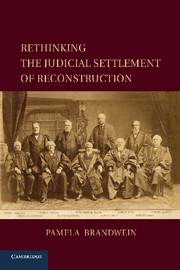Book contents
- Frontmatter
- Contents
- Acknowledgments
- 1 Abandoned Blacks?
- 2 The Emergence of the Concept of State Neglect, 1867–1873
- 3 The Civil/Social Distinction
- 4 The Birth of State Action Doctrine, 1874–1876
- 5 A Surviving Sectional Context, 1876–1891
- 6 The Civil Rights Cases and the Language of State Neglect
- 7 Definitive Judicial Abandonment, 1896–1906
- 8 Twentieth-Century Receptions
- 9 Conclusion
- Bibliography
- Index
8 - Twentieth-Century Receptions
Published online by Cambridge University Press: 03 May 2011
- Frontmatter
- Contents
- Acknowledgments
- 1 Abandoned Blacks?
- 2 The Emergence of the Concept of State Neglect, 1867–1873
- 3 The Civil/Social Distinction
- 4 The Birth of State Action Doctrine, 1874–1876
- 5 A Surviving Sectional Context, 1876–1891
- 6 The Civil Rights Cases and the Language of State Neglect
- 7 Definitive Judicial Abandonment, 1896–1906
- 8 Twentieth-Century Receptions
- 9 Conclusion
- Bibliography
- Index
Summary
The recoveries of the previous chapters make it clear that contemporaneous interpreters of Waite Court decisions saw them as endorsing a concept of state neglect and a broad theory of voting rights enforcement. But by the 1940s – just forty years after Judge Jones traced out the state neglect concept in Cruikshank, Harris, and the Civil Rights Cases – Justice Department attorneys and scholars had come to the conclusion that the decisions contained no such concept. Their readings of the state action cases took place in political, jurisprudential, and cultural contexts that had changed substantially from prior decades. I examine several features of the reconfigured contexts, namely, the institutional establishment of the scientific or “case” method of legal study at the turn of the twentieth century and the establishment of a new rights paradigm during the Progressive and New Deal eras. In focusing on these developments, I suggest in allusive but never conclusive fashion that legal and political practices obscured the intellectual and political contexts of state action cases, leaving the historical language of state action difficult to “read.”
Toward this end, I juxtapose two episodes in the reception history of the Civil Rights Cases and precursor decisions, one of which is the Justice Department's 1940s effort to prosecute lynching, in which lawyers concluded that a state neglect concept was absent in Waite-era decisions.
- Type
- Chapter
- Information
- Rethinking the Judicial Settlement of Reconstruction , pp. 206 - 239Publisher: Cambridge University PressPrint publication year: 2011

